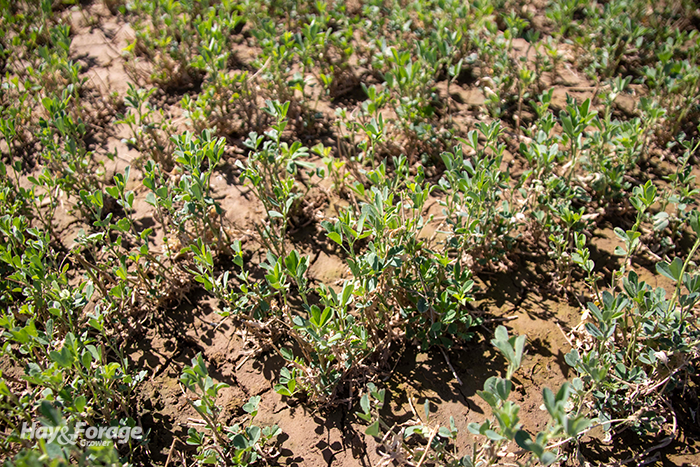
One of the redeeming values of alfalfa is that it has a deep root system, which allows it to reach subsoil moisture and stay relatively productive when topsoil moisture starts to become limited. But even alfalfa reaches a breaking point under severe drought conditions and will eventually shut down.
In the latest issue of NAFA News, which is published by the National Alfalfa and Forage Alliance, some good reminders are offered on how to deal with moisture-stressed alfalfa.
Moisture stress impacts the alfalfa plant in several ways. First, plant cell enlargement is reduced. The development of new plant shoots and buds is also inhibited if drought conditions persist during the first two weeks of a regrowth cycle. Stems that do develop will be shorter and flower earlier.
Even though moisture-stressed alfalfa will offer a significantly lower yield, forage quality can often remain relatively high. This is because the overall leaf-to-stem ratio improves despite smaller leaves.
Drought-stressed established alfalfa is managed differently than a nonstressed crop. If the plant height is over 10-inches tall and flowering, most agronomists recommend cutting the crop if its value is near or greater than the cost to harvest. Mow the alfalfa at a normal cutting height or above any regrowth shoots, whichever is higher. A higher cutting height will further improve forage quality because you essentially only harvest the leaf canopy.
Don’t cut a stand that is 10-inches tall or less and flowering. Rather, let the new regrowth shoots outgrow the existing short plants. Harvesting these short-stature stands will not promote a quicker regrowth as many people think.
Insect damage to drought-stressed alfalfa can be severe, so monitor and control pests such as potato leafhopper and armyworm. Left unchecked, insects will only amplify a drought’s impact on short- and long-term plant growth.
In most situations, moisture-stressed new alfalfa seedings should not be harvested until growing conditions improve.
Irrigated alfalfa
Where alfalfa is grown under irrigation, keeping stands productive hinges on water allocations. If water availability is restricted such that a full production allocation isn’t offered, it’s still better to provide full irrigation early in the season when yield potential is the greatest. Then, if need be, shut the water off during the heat of summer when forage quality and yield are often compromised anyway.
Alfalfa will go dormant after a period without water but has been shown to come back when favorable conditions return or irrigation is reinitiated.
Finally, experts recommend using moderate irrigation rates on fewer acres rather than lightly irrigating all acres. Putting limited water on more acres results in fewer tons of hay per inch of water because a larger percentage of water is evaporated from the soil as compared to what is transpired through the plant. More total alfalfa yield is produced on fewer acres with deficit irrigation. Focusing on fewer acres will also reduce harvesting costs in a yield-compromised year.

